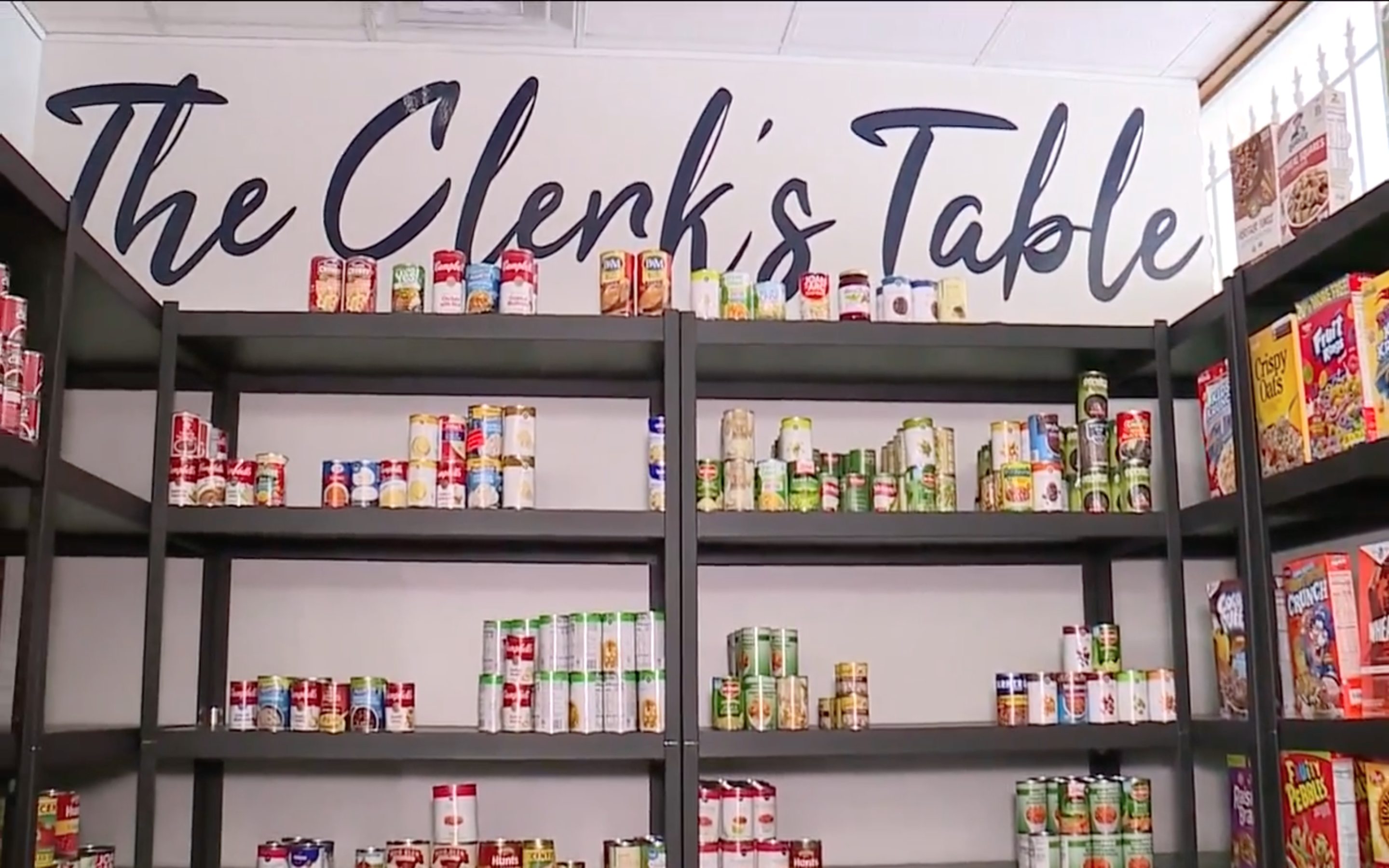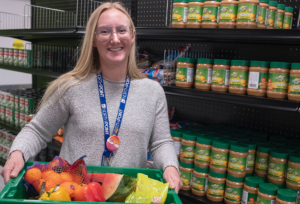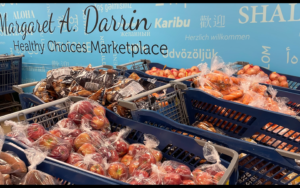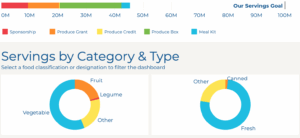Food banks are getting increasingly creative about where they put new distribution outlets.
In a bid to expand their reach, especially into underserved areas, food banks are making use of farms, libraries, county clerk offices, shopping malls, and even horse racetracks as food distribution points.
This attempt to meet people where they’re at is a departure from the way in which most food bank networks have been built up. A majority of distribution points have ended up in places like faith-based organizations where there were already plenty of resources to support them, including volunteers, donors and infrastructure.
“In most food relief, the agency network was built around where there was capacity, not where there was need,” said Thomas Mantz, CEO of Feeding Tampa Bay. “We’ve known for a long time that we have to fill in those gaps and provide direct services into those places ourselves, because sometimes it’s easier for us to do that, than to ask an agency partner to do it.”

In California, which includes one-third to one-half of the country’s total farmworker population, the California Association of Food Banks worked with a cohort of 11 food banks over the course of a year to devise ways to get more food into farming communities. The need on farms is especially acute because around 30% of households with farmworker income fall below the poverty line. Further, most farmworkers are excluded from federal minimum wage laws and other labor protections.
Regular convenings among the 11 food banks and various agricultural nonprofits generated a greater understanding of the best types of food to distribute to farmworkers, as well as ideal locations and times. With the help of the convenings, “food banks in those regions were able to start 92 different distributions that better met the needs of farmworkers,” said Stacia Levenfeld, CEO of the California Food Bank Association. She added, “Since the year that we did that intensive catalyst, the food banks have taken that program and they’ve run with it.”
Central California Food Bank took advantage of the CAFB programming and grant funding to launch its Farm Worker Distribution program. (The program is not the food bank’s only form of direct distribution. It also runs a mobile pantry program called Groceries2Go that lets people make an appointment to pick up food from one of 13 locations.)
For farm workers, the food bank deploys volunteers, including help from the California Farmworker Foundation, to drive trucks loaded with boxes containing shelf-stable food into the fields at seven farm sites, said Natalie Caples, Co-CEO. The Central Valley, despite comprising less than 1% of U.S. farmland, produces about a quarter of the nation’s food. However, many workers on the farms are foreign-born, excluding them from federal benefits even though they tend to live in remote areas with high levels of poverty.
FIND Food Bank, based in Indio, Calif., noted the importance of collaboration in establishing its Mercado Campesino or “Market for Farmers.” FIND has a long history of direct service, having run mobile markets, currently at 44 community sites, for more than ten years. Grant funding from CAFB allowed the food bank to work specifically with migrant farmworkers in Coachella Valley.
In designing the program, FIND collaborated with local organizations such as Growing Coachella Valley and relied on studies from the California Farmworker Foundation to further understand the needs and barriers of time and distance for the farmworkers. Informed by surveys compiled by CAFB, the food bank was able to provide specialty boxes with culturally appropriate food items for its predominantly Hispanic farmworker population.

“As easy as we want to make it sound to design the programs, there’s a lot of different people and organizations that go into it,” said Debbie Espinosa, President and CEO of FIND. “It’s a collective effort.”
Libraries are also proving to be good places to reach people in need. In St. Louis, Mo., food distribution at the county library evolved out of a long-standing relationship between the library and Operation Food Search. “We’ve got this great relationship with the library system, and we learned that librarians were aware that there were patrons who were coming in who were food insecure,” said Kristen Wild, President & CEO. “They were giving away their own lunches, or they were buying some crackers to have underneath the circulation desk.”
Operation Food Search has run child nutrition programs at the library over the years, including summer meals and produce distribution. Now it is also supporting pantries located in two branch libraries. The small-scale pantries, situated in back areas not accessible to the general public, mostly serve children and the unhoused. The pantries rely on general operating funds from the food bank to purchase items appropriate for kids and unhoused people, allowing the library staff to “curate” the offerings, Wild said.
Initially, there was concern that demand for the pantries would overpower both the resources and manpower of the library. To Wild’s surprise, that has not been the case, and the library has consistently received positive feedback from clients and suggestions to expand the pantries to more branches.
Using funding from the USDA’s Reach and Resiliency program, Long Island Cares set up food distributions at a local reservation for indigenous people, as well as at Belmont Park, the thoroughbred horse racetrack. At the reservation, the food bank hired a part-time staff person who also lives on the reservation to organize food distributions, as well as work toward establishing a permanent on-site pantry, said Paule Pachter, CEO.
At the racetrack, the food bank’s focus is a group of individuals and families who work in the “backstretch” area as groomers, walkers and caretakers for the horses. As with the reservation, Long Island Cares established a staff presence at the location to ensure distribution there on a regular basis. “We look to see the diverse communities that need our support, and we see if we’re able to develop something,” Pachter said.
Feeding Tampa Bay has long championed putting food pantries in schools, and now it is focusing on pantries for public servants. Employees who work in agencies like the county courthouse, the Sheriff’s department and city government offices, for example, may be earning more than minimum wage, but still struggling to make ends meet. Feeding Tampa Bay’s first civil-servant focused pantry, The Clerk’s Table, started in the county court clerk’s office in 2021.
Now the concept is expanding to other government agencies. Community leader Cindy Stuart, a former school board member and a main partner of the food bank’s in installing pantries in schools, helped jumpstart the focus on civil servants when she took office as the county clerk of the court in 2021 and asked the food bank for a pantry at her office. The approach lets Feeding Tampa Bay serve those not just at the bottom of the economic tier, but also “everyday community members” who are actively involved in the economy, Mantz said.
Perhaps more offbeat is Feeding Tampa Bay’s foray into placing a healthy food pantry inside a bike shop located in a local shopping mall. Wellbuilt Bikes, a nonprofit bike shop, hosts a pantry where people can fill food prescriptions from Feeding Tampa Bay’s healthcare providers. The Food Rx pantry is “really a suggested set of behaviors,” Mantz said. “They don’t necessarily need to go and get three apples or two. It’s more of, ‘Go shop, and here are healthy foods that would be conducive to your better health, your recovery, whatever that may be.’”
Locating the pantry in a shopping mall allows a greater number of people in the community to more easily access the service – and in a dignified manner. “There’s far less stigma associated with those places,” Mantz said. “It’s far different than the feeling of standing in a food line.” – Kathy Ou
Kathy Ou is a reporter and critic based in New York, bred in Southern California and born in Southern China. She is a student at New York University’s Cultural Reporting and Criticism program. Her writings have appeared on Prism, AsAmNews, The Yappie, The Amp and more.
PHOTO, TOP: The Clerk’s Table, supported by Feeding Tampa Bay, is a food resource for civil servants.
Like what you’re reading?
Support Food Bank News













